Digital PR Manager Olivia Bence explains why relationships are an increasingly important element of your PR strategy — and what you can do to turn a journalist into a brand ally.
Over the past few years, Digital PR has changed. Maybe it was the pandemic. Maybe it was the “fake news” epidemic. Or maybe it was the mass redundancies in news publishing.
Whatever it was, one thing’s certain: it’s harder than ever to get the attention of journalists.
As a result, PRs have had to change strategies and tactics to fit this ‘new norm’. We waved “goodbye” to pre-9am newsdesk sell-ins on the phone and “hello” to more personalised email approaches to break through overflowing inboxes.
But don’t worry: it’s still possible to cut through the noise. And the answer isn’t in better data or bigger stories. Instead, you need to be looking deeper and asking yourself: how strong is my relationship with this journalist?
In this blog, I’ll explain how you can create new relationships with key press contacts, how to nurture those relationships, and why it is well worth your time when time is an increasingly scarce resource.
It’s no surprise that Muck Rack’s State of Journalism 2023 report reflected just this. 92% of journalists prefer email pitches, while 24% will reject a relevant pitch if there is a lack of personalisation.
On top of this, we’ve also experienced job cuts from big publishing houses like Reach PLC, meaning journalists are stretched thin and covering multiple news desks.
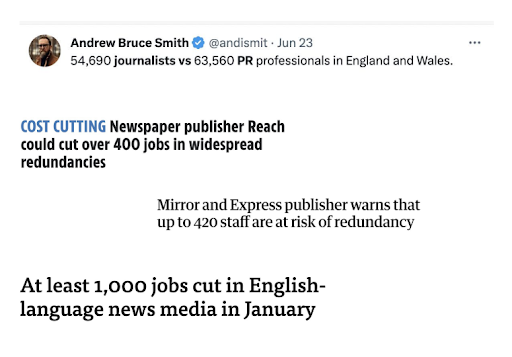
Source: Andrew Bruce Smith on X
A Tweet by Andrew Bruce Smith perfectly sums up what we’re having to deal with. The post simply highlighted how there are now more PR professionals compared to journalists.
The result? Even more competition for your stories and campaigns to make it through the door. There’s a renewed need for emails and subject headings to stand out from the crowd, and it’s creating a lot of extra admin for a professional group who are already overworked.
The solution is clear: you need to make life as easy as possible for journalists if you want a shot at getting coverage.
But how?
Journalists absolutely love praise, especially during these unpredictable times. But be careful: overdoing it or being aimless can come across as superficial or even (gasp) AI-generated. You need to be specific.
Here’s how you can massage their egos the right way:


This leads to the next point: it’s incredibly important to keep track of journalist moves.
We’ve already mentioned using X (formerly Twitter) as a good source, but media databases like Roxhill also provide bulletin updates on journalist moves. LinkedIn is another great source to use for updates.
Despite all of this, it can also be incredibly hard to find the time to sort through these. Try blocking out an hour on a Friday afternoon to do this, keep track using a spreadsheet and ensure the team keeps this updated to make sure nothing is missed.
Here’s one I prepared earlier:

It might seem like the last thing journalists want from PRs is questions. But sometimes, asking your journalists the right questions can help build rapport — and lead to better coverage as a result.
Here are some questions you might want to ask:
Muck Rack’s 2023 State of Journalism Report revealed that the majority of journalists want their PR pitches to include the following factors:
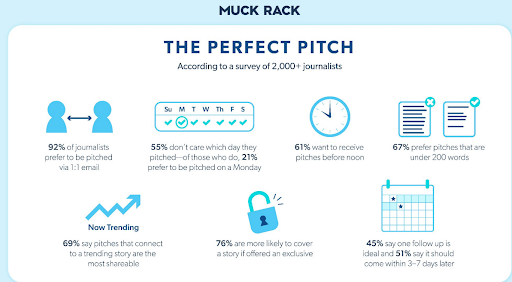
Source: Muck Rack’s 2023 State of Journalism Report
So, asking the right question could actually provide you with that bit of insight to make your pitch land with that one contact.
Here is an example of how we did just that with a key lifestyle journalist on Twitter/X. We simply introduced our client, and she was able to provide insight into where she worked and for what desk, allowing us to tailor our emails to her.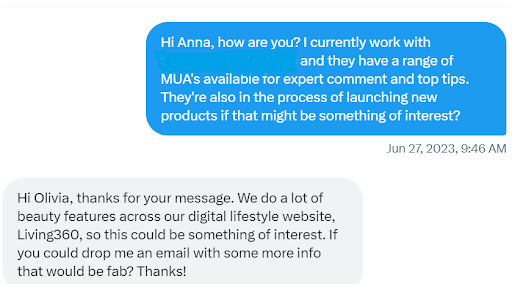
Conversation with a journalist asking what they’d be interested in covering.
One simple thing you can do to start building relationships is to thank journalists when they use your story. This is the perfect opportunity to ask them what they’re currently working on or introduce other clients you may be working with.
Not only does this help with keeping up the momentum within the relationship, but it also offers a helping hand that many journalists will appreciate. And best of all: it gives you an opportunity to introduce the journalists to other clients that might be relevant, too.
Below is an example of an email we have sent to a journalist that we’re currently working with. They were in the process of covering one of our stories, so we decided to send them some information from another client, which included topics and who they were. Their reply was fantastic; they got back in touch and asked if we knew any experts for the following questions.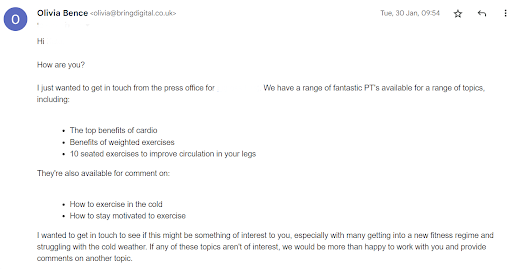
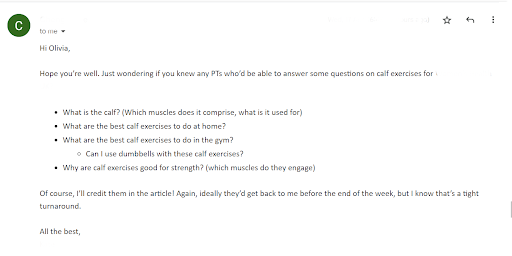
Email exchange with a journalist offering them commentary from another client
Sometimes, the best thing to do to get journalists to cover your story or campaign is to persuade them. But how?
Well, it starts with valid data and insights, especially data that’s going to incite an emotional response.
To start, it’s important to remember that journalists have to reach certain targets for their articles, from online views to traffic. To persuade them to use your story, you need to show them evidence that doing so will help them hit their KPIs.
Use Google Trends and search around your topic to see if there is a spike in searches related to your content; it’s a great incentive to include in your pitch emails as proof of demand. For example, when I look at trending topics in Fitness, search demand for “somatic exercises” has jumped more than 600% year-on-year. If I can offer commentary from a PT and show the journalist this data, it makes a more compelling argument for them to spend their time editing and publishing it.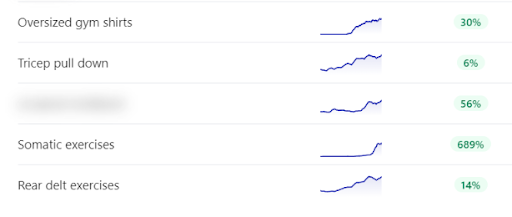
You can use Google Trends to help convince journalists that your topic is in demand
If you work with an SEO team and have access to tools like Ahrefs or Semrush, you can get more granular keyword data too, that you can include in pitch emails to SEO journalists. Trending X hashtags and popular TikTok videos are all great resources to persuade journalists your story or campaign is interesting — especially if you can provide viewing and interaction figures.
We’re living in a new age of communication, which is putting journalists under extreme working conditions. Now, it’s more important than ever to take a minute and look at your journalist relationships if something is struggling to cut through the noise. Taking simple steps and making small changes can make all the difference.
Struggling to get your brand the relevant links it deserves? Get in touch today to see how our Digital PR team can help.











